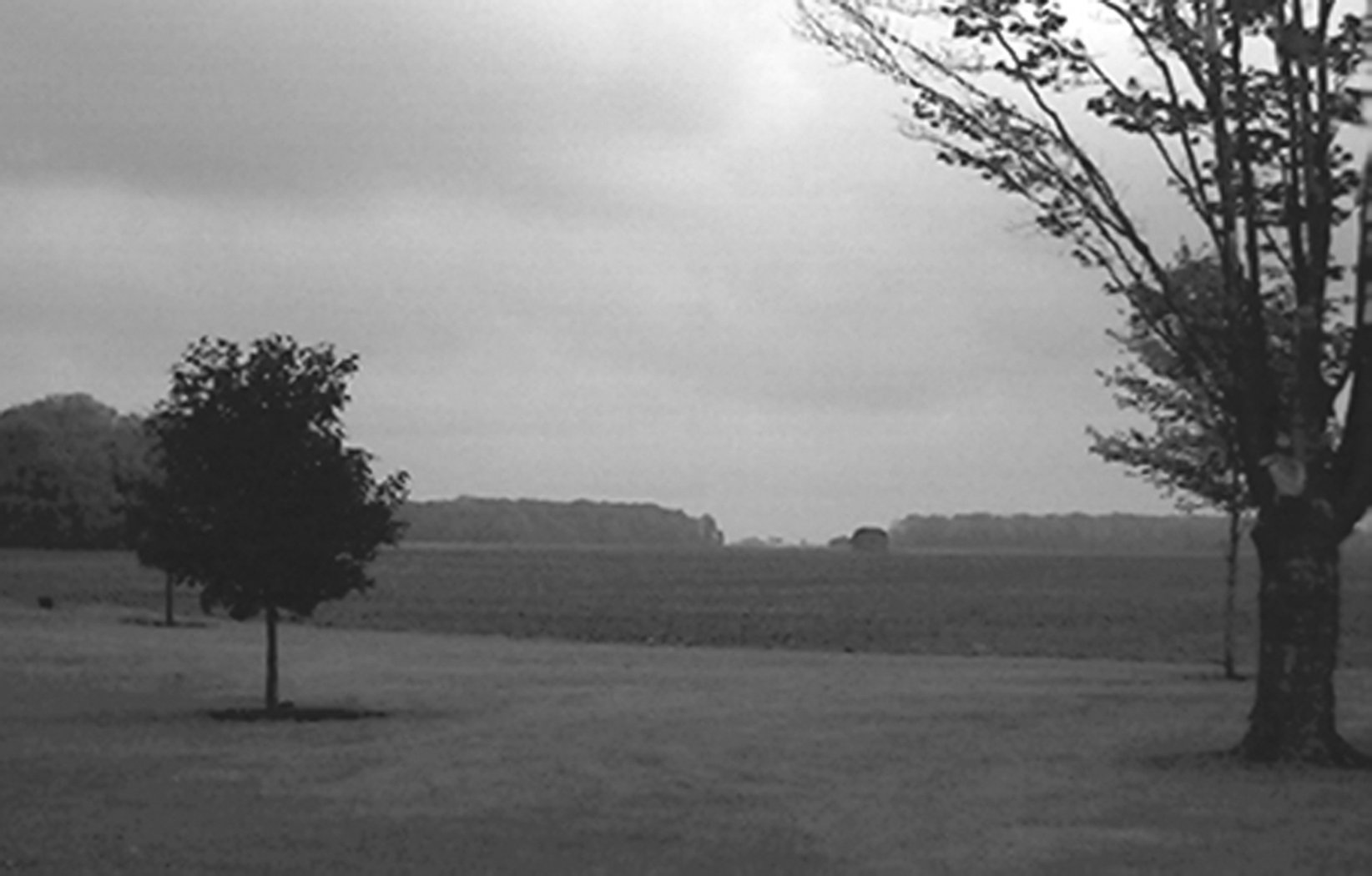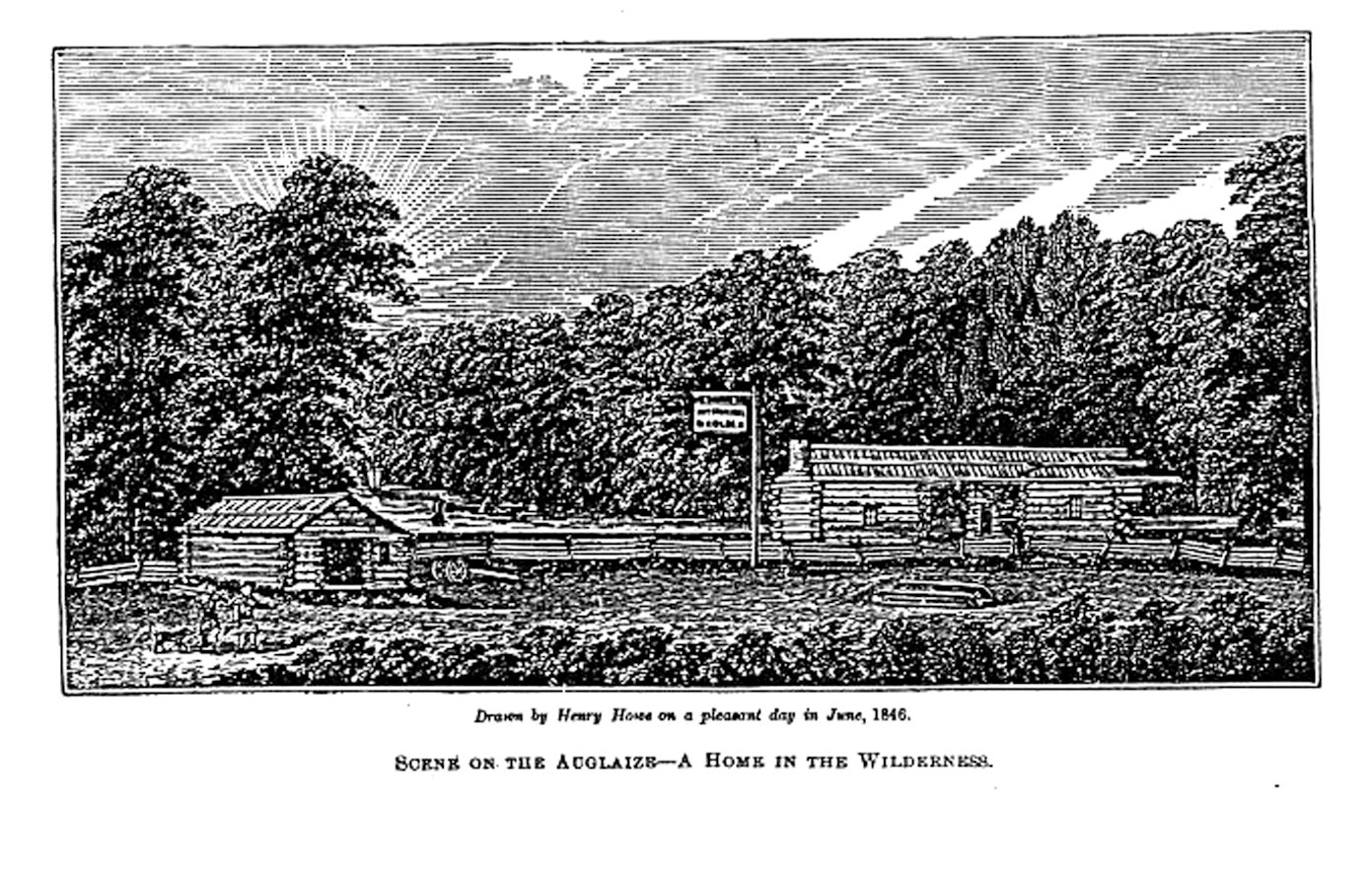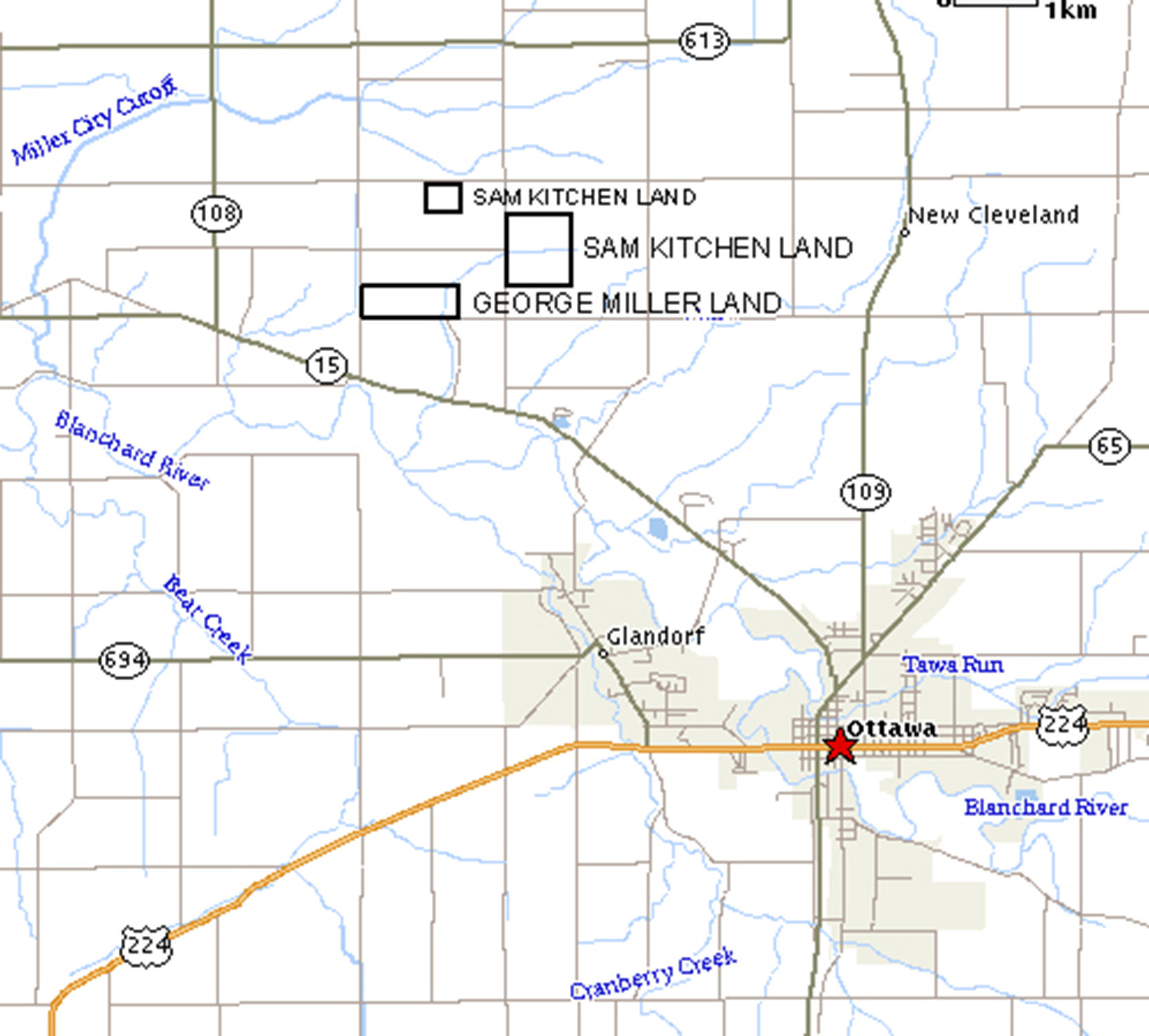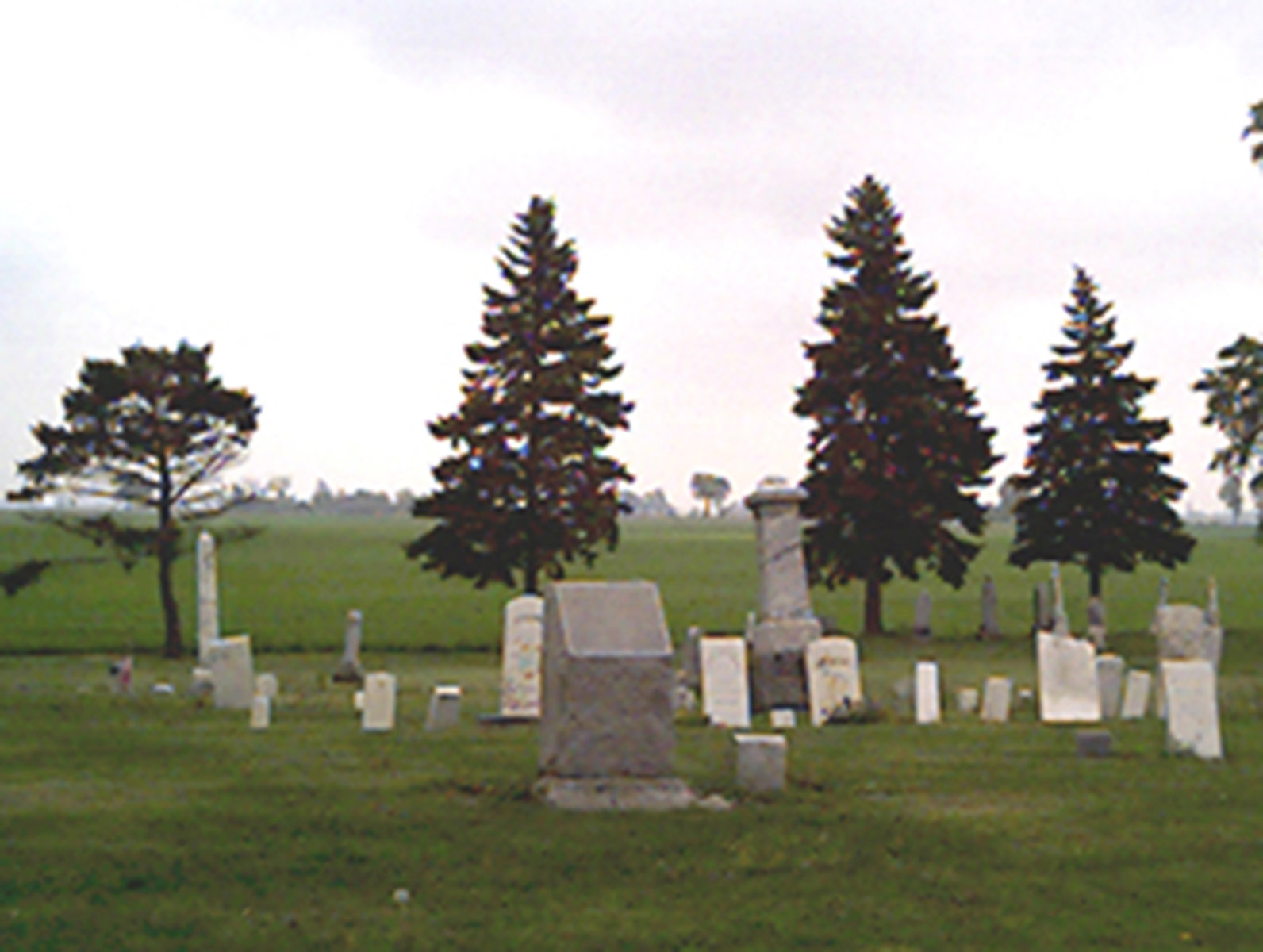George Miller
- Born: 8 Mar 1818, Loudoun County, Virginia 92
- Marriage (1): Sarah Ann Kitchen on 24 Aug 1844 in Canton, Stark County, Ohio
- Died: 29 Feb 1892, Putnam County, Ohio at age 73 93
- Buried: Old Center Cemetery, 3 miles west of Leipsic, Ohio on Road 10

 General Notes: General Notes:
George Miller worked as a flour miller in Millport, Ohio. He and his family moved by wagon and ox team from Millport, near Canton, in 1845-46 to a town called Buckeye on the bank of the Blanchard River. While living in the village of Buckeye during the next six years he worked during the day as a carpenter and cabinet maker and in the evening he was the village shoemaker. Having saved a little money he bought 40 acres of timbered land about 4 miles north of the village on which he was to make his home for several years, finally owning a total of 236 acres. Buckeye was later named Ottawa.
The Miller farm as shown on an 1880 map of Ottawa Township can be reached by taking Road 15 northwest out of Ottawa until you get to Township Highway 12H. Go north on 12H until you reach Road H which will turn sharply east. At this point the land to the north and west was the George Miller farm. An old hand drawn map of the property created by a family member shows that there was an indian burial ground on the property west of the farm house. All signs of the burial ground have disappeared.
The 1850 U.S. census lists the George Miller household members as George Miller, Sarah Miller and Thomas Miller. Though another source states he was a carpenter and shoemaker during this period of time, the census lists his occupation as a farmer. The real estate owned was valued at 80 dollars. This would not have been a lot of acreage, so he very possibly supplemented his income with other jobs as he grew the farm.
The 1880 U.S. census lists the George Miller household members as George Miller, Sarah Ann Miller, John H. Miller and Ollie Shoemaker.
THE MIGRATION
As told to Clarence F. Miller by his father John H. Miller
In the spring of 1845, George Miller, a farmer living in Stark County near Canton, Ohio, loaded all his earthly possessions, including his wife Sarah, into a canvas covered wagon. The wagon known as a "Prairie Schooner" was drawn by a team of oxen and was all fitted out as a crude portable home that would suffice until the couple could find a suitable farm in the wilds of north western Ohio. They had heard many tall tales of the fertility of the black rich soil to be found in the Maumee River Valley. They were told that they could obtain good hardwood covered land for a song along the Auglaize and Blanchard branches of the Maumee.
Discounting the critics' description of the region which was then called the "Black Swamp" and reportedly abounded in huge rattlesnakes, hostile Indians and evil vapors which brought on the dreaded ills of Ague, Rheumatiz and Malaria, our ancestors were confident that they were capable of overcoming all the disadvantages. They dreamed of draining, clearing and developing the area into a prosperous farmers' paradise.
Events of the past century have proved these dreams more than possible. An afternoon's drive through the area between Ottawa, Leipsic and Defiance will quickly convince the most skeptic critic that those hopes of the early settlers have been more than fulfilled. The well drained acres that stretch to the horizon are covered with beautiful well kept farms whose fields produce some of the most bountiful crops of corn, wheat, sugar beets, soy beans, tomatoes and livestock to be found anywhere in the nation. In spite of a handicap of only the equivalent of a third grade education, Grandfather Miller was confident in his ability to make a place for himself and family in these unknown wilds. He was well trained in not only pioneer agriculture, but he had several years experience as a carpenter, cabinet maker, flour miller, shoemaker and could cure and tan any kind of fur or hide.
He had chosen as a wife and equally well trained helpmate Sarah Kitchen. They had been married since August 24, 1844, and Sarah was now pregnant. She was well trained in the arts of homemaking, which included the knowledge and ability to spin and weave wool and flax and to preserve fruits and vegetables by canning or drying. She could fashion and sew the family clothing, make dye from the hulls of nuts or the juice of wild berries and last but not least she was trained in the use of simple remedies she could make from the wild herbs and weeds that grew in abundance along the wayside. Between he and his wife they had managed to save enough to outfit the expedition and had nearly one hundred dollars in gold hidden away in a secret hiding place Grandfather had conjured up in the wagon box.
Sarah had insisted that her part of the cargo must include balls of wool yarn, linen thread, steel needles, beeswax, bolts of cloth, blankets, bedding, her personal clothes and clothing for the little one whose arrival was expected sometime in August. Grandfather must take his carpenter tools, including broad axe, adz, froes for splitting clapboards, shingles and lath, coopers adz, crosscut saw and the set of molding planes that would enable him to embellish the furnishings of the new home. The wooden shoe lasts, awls, pegs, thread, etc. that comprised his shoemakers outfit also must be taken. He also included a spare set of oxen shoes, a spare wagon wheel, a keg of fresh water, axe, shovel, bucket, old grease to lubricate the wagon wheels and a cured hide to provide repairs for shoes and boots. At last the day of departure arrived. A tearful farewell during which Grandmother's kid sister pressed into her hands a package containing enough white satin to make the new baby a dress, and much advice which later proved both good and bad. Finally the young couple turned their faces westward along the trail, not daring to look back until they were out of sight of home and loved ones.
The plodding oxen moved the heavy wagon at what would now be considered a snail's pace. After a rain the day's journey was often limited to three or four miles and Grandfather would have to cut poles and brush to lay across the many washouts and mud holes encountered. When the sun shone and the trail passed over higher ground a record of eight or ten miles were often possible. Some days due to breakdowns or to give the team a rest, no progress was possible. Campsites were chosen where plenty of water, fuel and forage for the oxen was available, often beside a stream or spring or in a friendly farmer's barnyard where news and gossip could be exchanged.
Who can tell what plans and dreams those young stalwarts talked over during that slow journey to the west. No doubt one or the other had to lean on his or her partner more than once for encouragement. As the little cavalcade moved along and Sarah's time approached no doubt the young husband had to often take his bride in his arms to still her fears of the coming ordeal. Finally the time arrived and the wagon was pulled into the nearest farmyard. Grandfather tied the oxen to the fence, built a fire, filled the copper kettle with water and the swaddling clothes were laid out. No doctor within miles, the farmer's wife and Grandfather had to do the honors. Imagine the joy of the new parents when a tiny girl was born on that day August 19, 1845. They named her Elizabeth. She was a tiny frail little creature and the parents hurried as best they could to Bucyrus, the nearest town ahead for they realized they must have medical assistance. In spite of anything the doctor could do Elizabeth died in a few days of chills and fever. Grandfather bought some pine boards and put his tools and knowledge to work on their first carpenter job since leaving home; building a tiny coffin for his first born. Grandmother lined it with the satin her sister had given her. Grandfather dug the grave, read the burial service from the Bible, the little body was lowered to its last resting place and after the grave was filled a wooden cross was erected at the head as reminder to anyone passing by that here was buried the first hope and sorrow of a young couple westward bound.
The trail angled north west and at Carey they made contact with one of the new roads, just recently surveyed and called the Wyandot/Bryan road. In the early part of October 1845, the wagon stopped at Buckeye, a small village on the left bank of the Blanchard River. Across the river on the right bank was the Indian town of Ottawa. The Indian of the area were friendly and gave the white settlers no trouble. Here they agreed to stop for the winter and Grandfather promptly got a job for the winter, as carpenter and cabinetmaker.
They lived in the wagon until Grandmother found a job cooking at the local boardinghouse. In lieu of wages she accepted board and room for herself and husband. Grandfather found a small shed he could use as a shoe shop and after supper he often worked far into the night making and repairing boots and shoes for residents of the village and surrounding area. Prices were low and every effort to make or save a penny was made. By the winter of 1852 they had saved enough to buy a little farm of forty acres along the side of a creek called the "Runn". Legally described in Putnam County records in Vol 5, page 283 dated February 11, 1852. "George Miller and wife Sarah bought from L.D. Durbin and wife Ellen the S.W. 1/4 of the S.E. 1/4 of Sec. 6 T.P.I. - R. 7E. consisting of 40 acres. Signed before N.G. Smith J.P. recorded September 25, 1852 by S. Spencer." During the winter of 1852 he managed to cut enough timber to build a one room log cabin with puncheon floors, a fireplace built of stone, logs and sticks, the whole held together by a mixture of clay and lime. A clapboard roof completed the little home. Also a log barn with lean-to was built to house livestock and chickens. During this time he managed to haul a load of choice logs to the mill and have them sawed into lumber. From this lumber he made tables, chairs, cupboards, beds, spinning wheels (both wool and flax), washtubs, buckets, barrels and anything needed to furnish the simple home. He also made the wooden frames for plows, harrows and ox yokes, flails, shovels, rakes, grain cradles, scythes and everything he could possibly make to save a few pennies. His wife Sarah was just as busy weaving and spinning, making candles, soft soap, knitting sox, mittens, caps and sweaters, making curtains, clothing, bed ticks, blankets and quilts. She must also tend her garden, preserve all the fruits and vegetables possible, churn butter, make cheese, smoke meats, prepare the meals and help in the fields. Grandfather had set for himself the goal of five acres or more land to be cleared and broken to the plow each year. This was the very minimum necessary to survive he said. He must supplement this with any odd jobs that came his way. In the long winter evenings he continued to apply his trade of shoemaker. Or he would make a chair, cupboard or some other article of furniture for a neighbor. Grandmother would make straw hats from the reeds that grew along the Runn. Work clothes for the summer were made from the flax she gathered.
Springtime was a busy time for all. Maple sap had to be gathered and boiled for days to make syrup and sugar. Greens from the lowlands and morels were collected and added to the daily fare. The garden soil must be carefully prepared and planted; in addition to the ordinary vegetables a corner was reserved for herbs. Doctors were scarce and expensive and Grandmother had to cope with all minor ills by preparing medicine from the material at hand. Children were a necessary part of a pioneer's life. Their health, well being, education and spiritual training depending on their parents inspiration and determination to provide same.
The land was virgin and rich in fertility, but covered with dense forests of walnut, beech, maple, sycamore, buckeye, and many other species native to the area. The best land was the bottom ground along creeks and rivers. In addition to clearing, this land had to be drained. Stumps had to be pulled, rail fences built to keep both domestic and wild animals under control. The Miller family grew and prospered by dint of hard work and taking advantage of every opportunity.
From Grandfather's daybook I quote you a sample of how prices were 150 years ago:
James Crow Debtor Oct. 18, 1848 mending shoes and slippers .37 1/2
James Crow Debtor Dec. 17, 1848 mending boots .18 1/2
James Crow Debtor Dec. 17, 1848 made pair of fine shoes .68
J. Kitchen Debtor Dec. 25, 1846 two bushel corn .50
J. Kitchen Debtor June 16, 1847 upper leather for one pair shoe .50
J. Kitchen Debtor June 16, 1847 1/2 day hoeing corn .75
J. Kitchen Debtor July 3, 1847 1 day mowing hay .62
J. Kitchen Debtor July 5, 1847 1/2 day hauling hay .25
J. Kitchen Debtor July 5, 1847 3 bu wheat .75
J. Kitchen Debtor July 5, 1847 4 days cradeling 4.00
J. Kitchen Debtor July 5, 1847 2 days stacking 1.50
George Fuller Debtor June 10, 1856 1 calf 3.00
George Fuller Debtor June 10, 1856 1 gal coal oil .50
George Fuller Debtor June 10, 1856 1 ham of venison .50
George Fuller Debtor Dec. 4, 1856 15 bu oats 3.75
Ed Bowman Debtor Jan. 28, 1855 hauling iron and other goods 1.50
Ed Bowman Debtor Feb. 24, 1856 weaving 19 yards of flannel 1.90
Ed Bowman Debtor Sept. 18, 1851 45 bu ashes 1.80
Ed Bowman Debtor Nov. 21, 1851 1 pair boots & leather 3.00
Ed Bowman Debtor Sept. 20, 1853 1 grain cradle 2.50
Ed Bowman Debtor Dec. 28, 1853 2 fine shirts made 1.00
Ed Bowman Debtor Dec. 28, 1853 2 bushels turnips .25
Ed Bowman Debtor Dec. 28, 1857 18 lbs beef .72
Ed Bowman Debtor Dec. 28, 1857 1 shovel plow 2.00
Ed Bowman Debtor Dec. 28, 1857 1 days threshing .50
Ed Bowman Debtor Dec. 28, 1857 13 1/4 lbs pork .53
Ed Bowman Debtor Dec. 28, 1857 6 lbs salt .17
Ed Bowman Debtor Dec. 28, 1857 1 mowing scythe and swath 1.62 1/2
Ed Bowman Debtor Dec. 28, 1857 hauling freight 1.00
Taken from Putnam County history:
The M.E. Church of Ottawa was organized in 1855. The first church structure built in 1858 was of brick. The Ottawa Society was organized as a station in 1869 by the Rev. L.C. Webster who was presiding Elder. George Miller was Pastor in charge. Liberty Township was organized in April 1837. The first settler was A. Montooth in 1835. The land in the township was very swampy and not a good place to live. The first settlers therefore settled on the "Ridge". The lowland was mostly drained in the 1860s. The first town laid out was Medary in 1845. West Leipsic was platted in 1852. The town was incorporated in 1882 with the following officers - Reuel Haskell* Mayor, W. White Clerk, M. Prichard Marshall, T. James Treasurer. Elm Center was a lumber town, 4 miles west of Leipsic. Prentiss is directly north of W. Leipsic on the D.T.&I. The oldest road in the county is known as the "Anthony Wayne" trail and was cut by Anthony Wayne from Fort Recovery to Defiance in 1794 along the west bank of the Auglaize River. Along this road a tavern was built and known as "Bolivar Heights" or "Holdens Tavern". This was thought to be "The Home in the Wilderness" sketched by Henry Howe in 1846. The owner was Parson B. Holden, an early circuit rider who built a log church about 40 rods from the tavern. Parson Holden appears to have ministered both the "Spirit of Wine" and the "Spirit Devine". The D.T.&I. railroad was constructed in 1895-1899. This was the second railroad built by C. N. Haskell*, a Putnam County boy who later became the first Gov. of Oklahoma. His first railroad was the Findlay, Fort Wayne and Western; started in 1888, finished 1895 and sold to the C.H.&D. in 1902.
Further research positively identifies the "Home in the Wilderness" as the one described above. This was taken from travelling notes of Henry Howe. Reuel Haskell married Margaret Jane Miller and his brother, Charles N. Haskell, became Govenor of Oaklahoma.
OBITUARY
George Miller was born in Louden (Loudoun) county, Virginia, March 8, 1818. Came to Ohio when but a child, and to Putnam county in 1845. United in marriage with Sarah A. Kitchen in 1844. United with the M. E. church in 1857, and was a faithful, consistent member until his death which took place at his home Feb. 29, 1892. A widow, three sons, and two daughters are left to mourn their loss.
Surely death is no respector of persons; to one and all alike he comes; to some early, to others late, but to the good and true all too soon. We feel that a good man has gone out from our midst. And while the quiet little cemetery, near his home, holds all that is mortal of Father Miller, we know that life which he so freely gave to the cause he loved so well, will wield an influence for good for years yet to come. Thirty-five years of earnest devotion to Christ's cause does not cease at the grave. He could say as did the apostle, "For I am now ready to be offered, and the time of my departure is at hand." "I have fought a good fight, I have finished my course, I have kept the faith." May this bereaved family have the comforting influence of our Heavenly Father, and may this dispensation of His providence be the means of leading the entire family to repentance and salvation, is the earnest desire of one who was present.
George Miller is buried with his wife, Sarah Ann Kitchen, in Old Center Cemetery. Old Center Cemetery is located about 3 miles west of Leipsic. It is on the east side of Road 10 about a quarter mile south of the Road 10 and Township Highway X intersection.
The town of Ottawa, Ohio was established in 1834 where the last Ottawa Indian reservation existed. 94

 Noted events in his life were: Noted events in his life were:
1. Occupation: Farmer, 1880, Ottawa, Ottawa Township, Putnam County, Ohio. 95

2. Picture: Old Center Cemetery, 3 miles west of Leipsic, Ohio on Road 10. The Miller family farm was located at the northeast corner of Township Road C and Road 11-A in Putnam County, Ohio. This is not the original acreage purchased by George Miller and Sarah Ann Kitchen in 1852, but additional land purchased later. This is labeled "MILLER FARM" in the picture. "OLD CENTER CEMETERY" is the location of the cemetery where George Miller and Sarah Ann Kitchen are buried. It is on the east side of Road 10 about a quarter mile south of the Road 10 and Township Highway X intersection.

3. Picture: Putnam County, Ohio. This is a view northeast from the intersection of Township Road C and Road 11-A in Putnam County, Ohio. This is not the original acreage purchased by George Miller and Sarah Ann Kitchen in 1852. 80 acres owned by Sarah A. Miller shows up here on a 1895 plat map. This was 3 years after George Miller died. No evidence of a homestead was found on a visit in 2003.

4. Picture: Home in the Wilderness: Putnam County, Ohio. Ohio historian Henry Howe drew "A Home in the Wilderness" in 1846. George Miller and Sarah Kitchen arrived in Putnam county at this time. The picture is of a road house in Putnam county and illustrates living and the environment at the time. Further information can be found in notes pertaining to George Miller.

5. Picture: Stark county to Putnam county migration. George Miller and Sarah Kitchen made the journey west by covered wagon from Stark county to Putnam county (black areas on the map). It took about 6 months to make the journey in 1845. The grey area is Crawford county. The Millers stayed for a short period of time in Bucyrus, located in Crawford county, when their infant daughter died during their journey (see "The Migration").

6. Picture: Original Miller homestead. George Miller and Sarah Ann Kitchen's original land purchase in 1852 was 40 acres in the southwest corner of section 6 in Ottawa Township. By 1880 this had expanded to 109 acres according to an 1880 Township map. This map shows the location of the 109 acres and 2003 rivers and roads surrounding the property. The roads crossing the property (gray lines) no longer show on 2003 maps. The Miller's also owned additional land located elsewhere in Putnam County. The home was located at what is now 12398 Road 12H, Ottawa, Ohio.

7. Picture: Putnam County, Ohio. The adjoining map shows the location of the original Miller property in relation to the town of Ottawa.

George married Sarah Ann Kitchen, daughter of Wheeler Kitchen and Agnes Swisher, on 24 Aug 1844 in Canton, Stark County, Ohio. (Sarah Ann Kitchen was born on 26 Oct 1826 in Ohio,96 died on 31 Jan 1897 and was buried in Old Center Cemetery, 3 miles west of Leipsic, Ohio on Road 10.)
 Noted events in their marriage were: Noted events in their marriage were:
1. Alt. Marriage, 26 Aug 1844.
 Marriage Notes: Marriage Notes:
George Miller and Sarah Ann Kitchen were married by Jacob Reed J.P.
|








 General Notes:
General Notes: